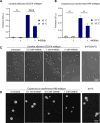Inhibitors of trehalose-6-phosphate synthase activity in fungal pathogens compromise thermal tolerance pathways
- PMID: 40852984
- PMCID: PMC12505902
- DOI: 10.1128/mbio.01795-25
Inhibitors of trehalose-6-phosphate synthase activity in fungal pathogens compromise thermal tolerance pathways
Abstract
Infections caused by fungal pathogens such as Candida and Cryptococcus are associated with high mortality rates, partly due to limitations in the current antifungal arsenal. This highlights the need for antifungal drug targets with novel mechanisms of action. The trehalose biosynthesis pathway is a promising antifungal drug target because trehalose biosynthesis is essential for virulence in Cryptococcus neoformans and Candida albicans and is also a mediator of fungal stress responses, such as thermotolerance. To exploit its untapped antifungal potentials, we screened the St. Jude 3-point pharmacophore library to identify small molecule inhibitors of the first enzyme in the trehalose biosynthesis pathway, trehalose-6-phosphate synthase (Tps1). Structure-guided optimization of a potent hit, SJ6675, yielded a water-soluble inhibitor named 4456dh. Employing biochemical, structural, and cell-based assays, we demonstrate that 4456dh inhibits Tps1 enzymatic activity, suppresses trehalose synthesis, and exerts a fungicidal effect. Notably, the structure of Tps1 in complex with 4456 reveals that 4456 occupies the substrate binding pocket. Importantly, 4456dh renders normally thermotolerant fungal pathogens unable to survive at elevated temperatures, which is critical as we investigate the emergence of fungi from the environment due to a warming climate. Overall, this work develops the water-soluble 4456dh as an early-stage antifungal drug that has a distinct mechanism of action compared to existing clinical antifungals.IMPORTANCEThe rise of fungal infections in recent years is alarming due to an increase in the vulnerable immunocompromised population, global temperature increase, and limited antifungal treatment options. One of the major hurdles in developing new drugs is the identification of fungal-specific antifungal drug targets due to highly conserved cellular machinery between fungi and humans. Here, we describe a small molecule inhibitor, 4456dh, of the trehalose biosynthesis pathway. This pathway is present in fungi but not in humans. Trehalose plays a critical role in stress responses such as thermotolerance in fungal pathogens and is essential for their virulence. We show that treatment with 4456dh blocks the production of trehalose and renders fungal cells inviable. Thus far, 4456dh is active against two fungal pathogens of critical importance, suggesting broad-spectrum activity.
Keywords: Candida; Cryptococcus; Tps1; antifungal; trehalose.
Conflict of interest statement
The authors declare no conflict of interest.
Figures






Update of
-
Inhibitors of trehalose-6-phosphate synthase activity in fungal pathogens compromise thermal tolerance pathways.bioRxiv [Preprint]. 2025 Jun 18:2025.03.07.642065. doi: 10.1101/2025.03.07.642065. bioRxiv. 2025. Update in: mBio. 2025 Oct 8;16(10):e0179525. doi: 10.1128/mbio.01795-25. PMID: 40370958 Free PMC article. Updated. Preprint.
References
-
- 2022. WHO Fungal Priority Pathogens List to Guide Research, Development and Public Health Action. World Health Organization, Geneva.
MeSH terms
Substances
Grants and funding
LinkOut - more resources
Full Text Sources
